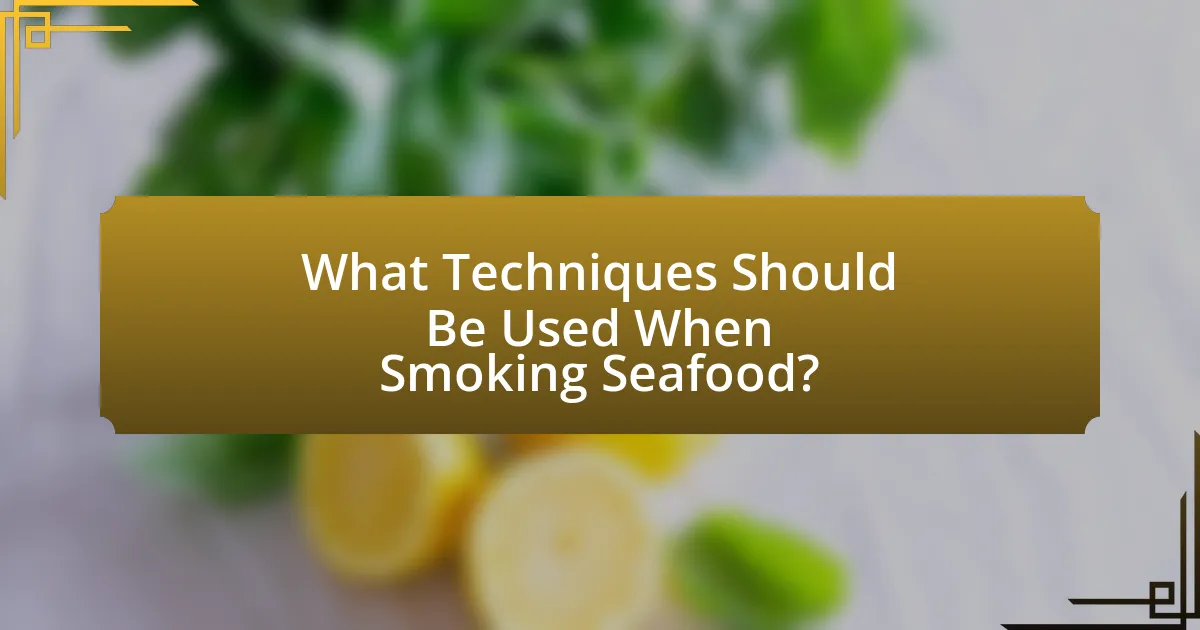A smoking gun is a kitchen tool designed to infuse seafood with smoke flavor by burning wood chips and directing the smoke into a chamber containing the food. This article explores the benefits of using a smoking gun for seafood, detailing how it enhances natural flavors, improves texture, and allows for precise control over smoke intensity. Key components of the smoking gun, suitable seafood types, and various smoking techniques, including cold and hot smoking, are discussed. Additionally, the article addresses health benefits, potential risks, and best practices for preparing seafood before smoking, ensuring optimal flavor and safety.

What is a Smoking Gun and How is it Used for Seafood?
A smoking gun is a kitchen tool that infuses food with smoke flavor by burning wood chips and directing the smoke into a chamber. In seafood preparation, it is used to enhance the natural flavors of fish and shellfish, providing a smoky aroma and taste without the need for traditional smoking methods. This technique allows chefs to control the intensity of the smoke and experiment with different wood types, such as hickory or applewood, to achieve desired flavor profiles. The smoking gun is particularly effective for delicate seafood, as it imparts flavor quickly and can be used in various cooking environments, including home kitchens and professional settings.
How does a Smoking Gun work in the context of seafood preparation?
A Smoking Gun works in seafood preparation by generating smoke from wood chips, which is then infused into the seafood to impart a smoky flavor. The device uses a fan to blow the smoke into a chamber where the seafood is placed, allowing the flavors to penetrate without cooking the fish. This method enhances the natural taste of seafood while providing a unique flavor profile that can elevate dishes. The use of a Smoking Gun is particularly effective because it allows for precise control over the intensity of the smoke, enabling chefs to customize the flavor according to the type of seafood being prepared.
What are the key components of a Smoking Gun?
The key components of a Smoking Gun include a combustion chamber, a fan, and a wood chip tray. The combustion chamber ignites the wood chips, producing smoke, while the fan disperses the smoke into the desired food item. The wood chip tray holds the wood chips, which are essential for generating different flavor profiles. These components work together to infuse seafood with rich, smoky flavors, enhancing the overall culinary experience.
How does the smoking process enhance seafood flavors?
The smoking process enhances seafood flavors by infusing the food with complex, aromatic compounds from the smoke, which interact with the natural flavors of the seafood. This infusion occurs through the absorption of smoke particles, which contain phenolic compounds that contribute to a rich, savory taste profile. Studies have shown that smoking can elevate the umami flavor in seafood, making it more appealing to the palate. Additionally, the smoking process can create a desirable texture and aroma, further enhancing the overall sensory experience of the dish.
What types of seafood can benefit from smoking?
Fish, shellfish, and certain types of crustaceans can benefit from smoking. Fish such as salmon, trout, mackerel, and tuna are particularly well-suited for smoking due to their rich flavors and oily textures, which absorb smoke effectively. Shellfish like scallops and shrimp also take on enhanced flavors when smoked, making them more savory and aromatic. Crustaceans, including lobster and crab, can develop a unique taste profile through smoking, adding depth to their natural sweetness. The smoking process not only preserves these seafood types but also enhances their flavor complexity, making them more appealing in culinary applications.
Which fish varieties are most suitable for smoking?
The fish varieties most suitable for smoking include salmon, trout, mackerel, and herring. These species possess high oil content, which enhances flavor and moisture retention during the smoking process. Salmon, for instance, is widely recognized for its rich taste and firm texture, making it a popular choice for both hot and cold smoking methods. Mackerel, known for its strong flavor, also holds up well to smoking, while herring is traditionally smoked in various cuisines for its unique taste. The oiliness of these fish contributes to a successful smoking outcome, ensuring that the final product is flavorful and moist.
How do shellfish respond to smoking techniques?
Shellfish respond positively to smoking techniques by absorbing the smoky flavors, which enhances their natural taste. The smoking process introduces compounds such as phenols and carbonyls, which contribute to a complex flavor profile. Studies have shown that smoking can also improve the texture of shellfish, making them more tender while adding a unique aroma. For instance, research indicates that smoked oysters exhibit a richer flavor and a firmer texture compared to their non-smoked counterparts.

What are the Benefits of Using a Smoking Gun for Seafood?
Using a smoking gun for seafood enhances flavor, adds complexity, and provides a unique presentation. The smoking process infuses seafood with rich, smoky notes that complement the natural taste of fish and shellfish. Additionally, the controlled environment of a smoking gun allows for precise flavor adjustments, enabling chefs to experiment with different wood types, such as hickory or applewood, to achieve desired profiles. This technique not only elevates the sensory experience but also preserves the moisture and texture of the seafood, making it more appealing.
How does smoking improve the flavor profile of seafood?
Smoking enhances the flavor profile of seafood by infusing it with rich, complex flavors from the wood smoke. The process of smoking introduces compounds such as phenols and carbonyls, which contribute to a savory, umami taste that complements the natural flavors of the seafood. Studies have shown that smoking can also create a desirable texture, making the seafood more appealing. For example, the Maillard reaction, which occurs during smoking, adds depth and enhances the overall sensory experience of the dish.
What unique flavors can be achieved through different wood chips?
Different wood chips impart unique flavors to smoked foods, enhancing the overall taste profile. For instance, hickory wood chips provide a strong, smoky flavor often associated with barbecue, while apple wood chips offer a mild, sweet, and fruity taste that complements seafood well. Cherry wood chips contribute a subtle sweetness and a rich color, making them ideal for fish. Mesquite wood chips deliver an intense, earthy flavor, suitable for robust meats but can overpower delicate seafood. Each type of wood chip interacts with the food’s natural flavors, creating distinct culinary experiences.
How does smoking affect the texture of seafood?
Smoking seafood enhances its texture by introducing a firm, slightly chewy quality while also creating a moist interior. The process of smoking causes proteins in the seafood to denature, which results in a firmer structure. Additionally, the heat from the smoke helps to seal in moisture, preventing the seafood from becoming dry. Studies have shown that smoking can also create a desirable crust on the surface, contributing to an appealing mouthfeel. This combination of firmer texture and retained moisture makes smoked seafood particularly enjoyable.
What health benefits are associated with smoked seafood?
Smoked seafood offers several health benefits, primarily due to its rich nutrient profile. It is an excellent source of high-quality protein, omega-3 fatty acids, and essential vitamins and minerals. Omega-3 fatty acids, found abundantly in fish like salmon and mackerel, are known to support heart health by reducing inflammation and lowering blood pressure. Additionally, smoked seafood often retains beneficial nutrients such as vitamin D and selenium, which contribute to bone health and immune function, respectively. Studies indicate that regular consumption of omega-3-rich foods can lower the risk of chronic diseases, including cardiovascular disease and certain types of cancer.
How does smoking impact the nutritional value of seafood?
Smoking seafood can enhance its flavor while potentially altering its nutritional value. The smoking process can lead to a reduction in certain nutrients, such as omega-3 fatty acids, due to exposure to high temperatures and prolonged cooking times. Additionally, smoking may introduce harmful compounds like polycyclic aromatic hydrocarbons (PAHs), which can negatively affect health. However, smoking can also preserve seafood by inhibiting microbial growth, thereby extending shelf life. Studies indicate that smoked fish retains a significant amount of protein and essential minerals, but the overall nutritional profile may vary based on the smoking method and duration.
Are there any health risks to consider when smoking seafood?
Yes, there are health risks to consider when smoking seafood. Smoking seafood can lead to the formation of harmful compounds such as polycyclic aromatic hydrocarbons (PAHs) and nitrosamines, which are associated with an increased risk of cancer. Studies have shown that PAHs can form when organic materials, like wood chips used in smoking, are burned at high temperatures, potentially contaminating the seafood. Additionally, improper smoking techniques can result in inadequate cooking, leading to foodborne illnesses from pathogens like Vibrio or Listeria. Therefore, it is crucial to follow safe smoking practices to minimize these health risks.

What Techniques Should Be Used When Smoking Seafood?
The primary techniques used when smoking seafood include cold smoking, hot smoking, and the use of a smoking gun. Cold smoking involves exposing seafood to smoke at temperatures below 90°F, which enhances flavor without cooking the fish, making it ideal for delicate items like salmon. Hot smoking, on the other hand, cooks the seafood while infusing it with smoke flavor, typically at temperatures between 120°F and 180°F, suitable for firmer fish like mackerel. The smoking gun technique allows for controlled smoking, enabling the infusion of various wood flavors directly onto the seafood, providing versatility in flavor profiles. These methods are validated by culinary practices that emphasize the importance of temperature control and wood selection in achieving desired taste outcomes.
How can one effectively use a Smoking Gun for seafood?
To effectively use a Smoking Gun for seafood, one should start by selecting the appropriate wood chips, such as alder or applewood, which complement the delicate flavors of seafood. The process involves placing the seafood in a container, using the Smoking Gun to generate smoke, and allowing the seafood to absorb the smoke for a few minutes. This method enhances the flavor profile without overpowering the natural taste of the seafood. Studies show that cold smoking can add a subtle smokiness while preserving the texture and moisture of the seafood, making it an ideal technique for items like salmon or scallops.
What are the best practices for preparing seafood before smoking?
The best practices for preparing seafood before smoking include cleaning, brining, and drying the seafood. Cleaning ensures the removal of any contaminants and scales, which is essential for food safety. Brining, typically using a saltwater solution, enhances flavor and moisture retention, making the seafood more succulent during the smoking process. Drying the seafood, either by air-drying or using a paper towel, helps form a pellicle, a tacky surface that allows smoke to adhere better, resulting in a more flavorful product. These practices are supported by culinary techniques that emphasize the importance of preparation in achieving optimal flavor and texture in smoked seafood.
How long should seafood be smoked for optimal flavor?
Seafood should be smoked for optimal flavor between 30 minutes to 2 hours, depending on the type and thickness of the seafood. For example, delicate fish like trout may require only 30 to 45 minutes, while denser fish such as salmon can benefit from smoking for up to 2 hours. This time frame allows the seafood to absorb the smoke flavor without becoming overly dry or tough. Studies indicate that the ideal smoking duration enhances the Maillard reaction, which contributes to the development of rich flavors and aromas in smoked seafood.
What common mistakes should be avoided when smoking seafood?
Common mistakes to avoid when smoking seafood include using the wrong type of wood, overcooking, and not brining the seafood beforehand. Using inappropriate wood, such as softwoods like pine, can impart undesirable flavors; instead, hardwoods like hickory or apple are recommended for a better taste. Overcooking seafood can lead to a dry texture; maintaining the correct temperature and monitoring cooking time is essential for optimal results. Additionally, failing to brine seafood can result in a lack of moisture and flavor; brining enhances the overall taste and helps retain moisture during the smoking process.
How can over-smoking affect the taste of seafood?
Over-smoking seafood can lead to an overpowering and bitter taste, masking the natural flavors of the fish or shellfish. When seafood is exposed to excessive smoke, the compounds in the smoke can create a charred or acrid flavor profile that detracts from the delicate nuances of the seafood. Studies have shown that the balance of smoke flavor is crucial; for instance, a study published in the Journal of Food Science indicates that optimal smoking times enhance flavor, while prolonged exposure results in undesirable taste alterations. Therefore, controlling the smoking duration is essential to preserve the seafood’s inherent qualities.
What are the signs of improperly smoked seafood?
Signs of improperly smoked seafood include an off or rancid odor, a slimy texture, and discoloration. These indicators suggest that the seafood has not been adequately preserved or cooked, leading to potential spoilage. For instance, seafood should have a fresh, briny smell; any sour or ammonia-like scent indicates spoilage. Additionally, a slimy surface can signal bacterial growth, while discoloration, such as dull or grayish hues, may indicate that the seafood is no longer safe to consume. Proper smoking techniques should ensure that seafood remains firm, flavorful, and visually appealing.
What are some tips for achieving the best results with a Smoking Gun?
To achieve the best results with a Smoking Gun, ensure you use high-quality wood chips that complement the seafood’s flavor, such as applewood or hickory. The choice of wood significantly influences the smoke’s taste, enhancing the overall flavor profile of the seafood. Additionally, maintain a consistent airflow during smoking to ensure even distribution of smoke, which prevents any bitter taste from developing. It is also crucial to allow the seafood to rest after smoking; this helps the flavors to meld and intensify. Finally, experiment with different smoking times to find the ideal balance between smokiness and the natural flavor of the seafood, as over-smoking can overpower the dish.
How can one experiment with different flavor profiles using a Smoking Gun?
To experiment with different flavor profiles using a Smoking Gun, one should select various types of wood chips, herbs, or spices to create distinct smoke flavors. For instance, using hickory chips imparts a strong, robust flavor, while applewood offers a milder, sweeter profile. By adjusting the smoking time and the amount of smoke introduced, one can further refine the flavor intensity. Additionally, pairing smoked seafood with complementary ingredients, such as citrus or savory sauces, enhances the overall taste experience. This method allows for a versatile exploration of flavors, as evidenced by culinary practices that utilize smoking techniques to elevate dishes.
What tools and accessories enhance the smoking process for seafood?
Tools and accessories that enhance the smoking process for seafood include a smoking gun, wood chips, a thermometer, and a smoke box. The smoking gun allows for controlled smoking, infusing seafood with rich flavors while maintaining moisture. Wood chips, such as hickory, apple, or cherry, provide distinct flavor profiles that complement various types of seafood. A thermometer ensures that seafood is cooked to the appropriate internal temperature, enhancing safety and quality. A smoke box can be used in grills or ovens to contain wood chips, allowing for even smoke distribution. These tools collectively improve the smoking experience, ensuring flavorful and perfectly cooked seafood.

Leave a Reply